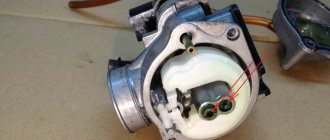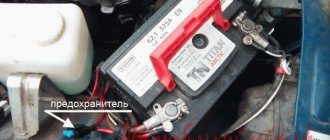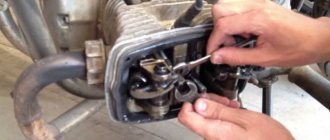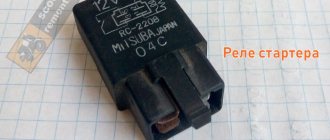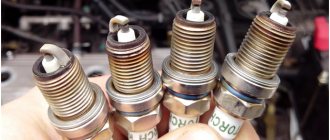One of the most popular two-wheeled vehicles in the world is, of course, the scooter! Many people start with them, since this type of motorcycle is characterized by simple operation and an affordable price. But, as a rule, beginners have no experience in repair and maintenance. In this article we will help you figure out what to do if your scooter does not start. Let's look at standard faults that make the scooter difficult to start. The most important thing in troubleshooting is to learn to recognize it by certain signs and proceed from simple to complex. Sometimes the reason is the most banal - the gas ran out, the battery was discharged, they forgot to turn on the power button or open the gas tap (on a moped). If these conditions are met, but the scooter still doesn’t start, we dig deeper.
Main reasons
So, let’s look at why the 4t scooter won’t start – the reasons can be roughly divided into the following categories:
- fuel system malfunctions
- ignition system malfunctions
- piston group malfunctions
- malfunction of the gas distribution mechanism (GRM).
Each of these 4 categories has its own several possible causes. When diagnosing a scooter, you should carefully pay attention to each category and the problem in it. Step by step, eliminating faults, you will definitely find the cause. And then it’s a matter of technology!
Advice! Remember that there may be several reasons. Therefore, having eliminated one breakdown, you should still check the serviceability of other devices from the list of possible faults.
Fuel system malfunctions
If there is no gasoline in the tank, the scooter will not start - everyone knows. The same situation occurs when the fuel system malfunctions - gasoline does not reach the combustion chamber. The consequence is that there is nothing to burn, so the engine does not start. The reasons may be as follows:
- faulty fuel valve
- clogged fuel filter
- contaminated carburetor, failure of its individual parts
- The vacuum suction supplied to the fuel tap does not work.
Tap
It is recommended to start repairs with the simplest ones. In this case, the diagnosis begins with the fuel tap (if there is gasoline in the tank). To check operation, remove the fuel supply hose from the carburetor, then crank the engine with the starter or crank. The serviceability of the tap will be visible by the stream of gasoline flowing from the hose.
The first thing you need to do is make sure there is gasoline in the fuel tank by opening the gas tank cap and looking inside
To make sure that the fuel tap of the scooter is working properly, you should disconnect the gasoline supply hose from the carburetor and, after cranking the engine, make sure that gasoline is flowing from the hose in a stream (observe fire safety measures!)
A constant flow of fuel, even when the engine is stopped, or a lack of fuel supply through the hose indicates a breakdown of the fuel valve. If fuel is constantly leaking, change the valve immediately. Otherwise, you should pay attention to the condition of the fuel hoses, and only then replace the fuel tap.
Filter
The serviceability of the filter is diagnosed visually and by blowing. A dirty filter should be replaced immediately. If the filter looks clean, but does not blow in the desired direction, it means it is clogged and requires replacement.
Carburetor
A dirty carburetor is another reason why fuel does not reach the combustion chamber. The device becomes dirty due to poor filters (fuel and air) and poor fuel quality. Here is a list of actions necessary to eliminate carburetor malfunction:
- remove the carburetor and disassemble it
- rinse and blow out the holes with compressed air (if compressed air is not available, use a regular pump)
- pay attention to the condition of the float chamber, both the float itself and its adjustment; condition of the locking needle - is it worn out or sunk?
- Clean the fuel nozzle thoroughly.
Remember! There are no small details in carburetor repair! One missed moment may cost you to clean the entire carburetor again and find out the cause.
Ignition system malfunctions
Another possible reason why the engine does not work is a malfunction of the ignition system. This group includes many different little things, each of which can become the main reason for the engine not starting.
- dirty or faulty spark plug
- high voltage wire
- ignition coil
- faulty ignition sensor
- failed switch.
Spark plug
Let's start our search again with the simplest thing. Unscrew the spark plug from the cylinder, put a cap on it and lean the electrodes against the cylinder. Next, rotate the engine with the starter. In this case, a spark should jump between the two electrodes of the spark plug - straight and curved. If it is missing, you should perform a number of actions:
- Clean the spark plug from carbon deposits and oil contaminants using a rag and a metal brush
- warm the candle on the fire of a gas burner
- set the optimal gap between the electrodes - the gap should be about 1-1.5 mm.
After completing these steps, check for spark again. If it appears, then you can try to start the engine. If there is no spark, replace the spark plug with a new one. If there is no spark on the new spark plug, you should pay attention to deeper problems.
To check the spark in the spark plug, lean it against the metal frame (engine) and turn the engine
High voltage wire
The most common problem with a wire is its exposure in a certain place (broken wire). A working wire should spark off the cylinder body or other metal part of the engine when the tip is removed.
If it’s not scary, you can check for voltage with your finger, but it’s better to rest it against the engine. A broken wire will conduct electricity at the break point without reaching the spark plug. The exposed area should be insulated or the wire replaced with a new one.
You can check the high-voltage wire using a special indicator screwdriver
Ignition coil
To test the ignition coil, you need a device for measuring electrical quantities - a multimeter. Disconnect the coil from the scooter: remove the tip of the wire from the spark plug, unscrew the bolt securing the coil and disconnect its contacts.
Using a multimeter, measure the resistance at the coil contacts. Also measure the resistance between the contacts and the spark plug output. The optimal values for the coils of different scooters can be found by the model of the scooter. For example, the optimal resistance of the primary winding of the ignition coil on a Honda Dio scooter is 0.2-0.3 Ohm; secondary winding - 8.2-9.3 kOhm.
Checking with a multimeter
Piston group malfunctions
Having an insufficient degree of air compression in the engine cylinder, the scooter starts poorly or does not start at all. Experienced scooter riders can immediately determine the approximate compression level. A conclusion about the value of compression can be made by trying to start the moped with a kick starter.
When more effort is required in a certain position, it means compression is present. If the leg does not provide resistance, then the necessary pressure is not created in the cylinder. To be more sure, you should use a compression gauge.
Unscrew the spark plug from the cylinder and insert the tip of the device there. Rotate the engine with the starter. The compression meter will show the exact value of the compression ratio. The optimal compression value is 10 kg/cm2. If the compression in the engine is less than 7 kg/cm2, the piston should be repaired or replaced.
Checking with a compression gauge
Timing faults
You don’t need to read this paragraph if you have a 2-stroke scooter, because such engines do not have a timing belt. The cause of a timing belt malfunction may be carbon deposits on the valves or improper adjustment.
This is what the gas distribution mechanism (GRM) of a scooter looks like
You can check the air leak by placing your hand against the air filter hole on the carburetor. You should feel the creation of a vacuum with your hand. You can attach a plastic bag to the hole and rotate the engine - the bag should be pulled inside the carburetor and tear.
Check using a plastic bag placed over the neck
If this does not happen, it is recommended to get to the timing mechanism and repair it. If necessary, cleaning should be done.
Why is there no spark?
The second most common problem is why the scooter won’t start - there is nothing to ignite the fuel, or there is a spark - but there is nothing to ignite. To check the spark, you need to remove the spark plug cap and unscrew the spark plug. It must be dry and clean. The gap between the electrodes is needed 0.6-0.7 mm. The first sign of a lack of spark is that the spark plug is wet and smells of gasoline. This means the fuel did not burn in the cylinder and remained on the spark plug. Dry and clean it, then insert it into the cap and lean it against the cylinder mass.
At the same time, press the starter button for a second or the kick starter a couple of times. The spark between the spark plug electrodes should be clearly visible. If there is no spark, then replace the spark plug with a new one, most often this is the problem.
You may be interested in how to adjust the ignition on Ural motorcycles or install electronic ignition on Izh Jupiter 5 yourself.
The quality of gasoline in Russia is not very good, this quickly kills spark plugs, especially iridium ones. If a spark does not appear with the new spark plug, we look for a fault in the wiring. A broken wire or oxidation connecting the ground between the frame and the engine is a common problem. Another reason could be a burnt-out resistor in the spark plug cap. It can be checked with a multimeter; the resistance should be about 5 kOhm. If this is not the problem, then check the ignition coil, this can also be done with a multimeter. In this case, the resistance of the primary and secondary windings is checked. The resistance of the primary winding, as a rule, tends to zero. Well, the resistance of the secondary should be several kOhms. There shouldn't be a break.
It is also worth checking the switch by replacing it with a known good one.
The next possible malfunction is a break in the wire coming from the ignition switch or the wire coming from the switch. Check the wires for breaks or abrasions. Check the reliability of the female-male plug connections. If no visible damage is found, a wire break can be detected by testing each wire with a multimeter. If the above manipulations did not produce results and a spark never appeared, the last reason for its absence is failure of the generator, pulse sensor or generator windings, which happens extremely rarely. The generator windings can also be checked with a multimeter.
Principle of operation
Why won't my scooter start? There can be many reasons for this - from a small malfunction of the engine to a serious breakdown. A moped differs from other types of vehicles in that it is an economical mode of transport. A typical average scooter has a 50cc engine, which is unable to burn too much fuel while driving. This explains the fact why it cannot reach very high speeds. The maximum he can do is move at a speed of no more than 60 kilometers per hour. At the same time, the safety of the moped driver is at risk, since no side safety bars are provided here, as on full-fledged motorcycles. But the reliability and simplicity of the design of this relatively cheap vehicle are so convenient for everyday use that the scooter has always been, is and will be popular among the people.
But even the most unpretentious equipment sooner or later begins to act up and let down its owners. And then one fine day you are faced with the fact that the scooter will not start. This may be due to careless handling, lack of timely technical inspection, as well as objective extraneous causes, consequences of an accident, and the like.
Scooter carburetor clogged
Another important point is that the jets and channels of the scooter’s carburetor are clogged. In this case, as stated in many articles, normal starting and stable idle operation are unlikely. Of course, in this case, you need to remove the carburetor and blow out the jets and channels with a special liquid. The jets must first be unscrewed. Don't forget also about the channels of the starting enrichment. We looked at how to properly clean a scooter carburetor here.
Insufficient fuel
Fuel may not flow due to a jammed carburetor shut-off needle. This is possible when it is clogged, or because the level in the float chamber is out of whack. It is necessary to disassemble the carburetor, blow out all channels and jets with compressed air. You can use a bicycle pump for this. After cleaning, check that the float and the rubber seal on the shut-off needle are intact, and adjust the floats. The position of the floats must be horizontal. Otherwise, by bending the tongue under the locking needle, achieve a horizontal position of the floats on the inverted carburetor. After putting it back together, use a transparent hose to accurately check the fuel level. You can use the VAZ washer hose. by connecting it to the carburetor sump and unscrewing the drain screw, the fuel level should be level with the joint of the bottom cover +/- 2mm as in the figure below:
By the way, if the scooter does not start in the cold, in the morning, or in the fall, then the solenoid enrichment valve is most likely faulty.
Malfunctions in the power system
If there is a spark, but after that the scooter does not start, there is a high probability that fuel is not supplied. To address this issue, start checking at the gas tank. It is advisable if the gas tank is at least half full. To ensure that fuel is supplied to the carburetor, remove the fuel hose from the carburetor by lowering it into a previously prepared container (bottle).
Are all settings normal? But why won't the alpha moped start? See all possible faults!
As a rule, scooters have a built-in vacuum gas valve that opens the fuel supply only during startup or operation of the scooter. To check the valve with the fuel hose lowered into the bottle, we try to start the engine for 3-5 seconds, or until a stream of gasoline appears. In this case, the stream must be constant, at least “as big as a match”. If there is gasoline, but does not flow, the gas valve must be replaced.
If it is working, we look for the cause in the carburetor. First, the air filter must be clean. Because if there is a leak at the junction of the carburetor with the intake pipe, air is sucked in there, the mixture becomes too lean and starting the engine will be impossible. Make sure the gaskets between the carburetor are intact. Let's go further, the reason may be in the carburetor itself.
How to restore starting from the starter
How to start a car with a pushrod
The moped does not start well from the starter, however, doing it from the foot is simple and easy. If the engine does not start well from the starter, you must first check the fuse located in the battery compartment.
The location of the fuse on the battery is marked with an arrow.
Due to the often poor quality of the manufacture of the fuses, and, consequently, the entire starter, the wire located inside the starter glass bulb can barely touch the contact caps, which is why the fuse contact becomes unsuitable. After the low-quality fuse has been replaced, the moped can be started using the starter.
Typical problems with the ignition system of Chinese scooters
There are times when scooter owners are faced with the problem that it will not start. The reasons for this can be different, but there are also quite typical ones. In some cases, fixing the problem takes a few minutes.
Let's look at several reasons that lead to the scooter not starting. All examples are real, obtained during the repair of the Chinese scooter ABM Storm L and Motoland VXR5 .
The scooter does not start with the button.
If the scooter does not, but starts from the kickstarter without problems (from the “leg”), then you should pay attention to the main fuse, which is located in the battery compartment.
This same fuse may be the cause. There was a real case when, when measuring the voltage at the battery terminals, 13 volts was displayed on the multimeter display. The norm, considering that the battery was slightly discharged.
When measuring the voltage after the fuse, the multimeter showed 12.8 volts. Wonderful, isn't it? Does a piece of wire (fuse) really drop 0.2 volts? In theory, this shouldn't happen. The voltage in the scooter's electrical network after the ignition switch was also measured. The voltage was a little more than 5 volts and was fluctuating. The turn signal relay also began to crackle ungodly after the scooter was started with the kickstarter and the turn signals were turned on.
Due to the fact that the fuse was made, to put it mildly, poorly, the wire inside the glass bulb barely touched the contact caps. Because of this, the electrical contact in the fuse was poor. This is where those 0.2 volts of voltage were lost.
Due to the fact that the turn relay received undervoltage, it crackled, since the supply voltage was sometimes enough to operate the electromagnetic relay, sometimes not.
Also, when pressing the “Start” button, the starter, which spins the engine shaft when starting, did not start. Naturally, since the voltage in the scooter's electrical network was underestimated due to a faulty fuse.
After replacing the faulty fuse, the scooter began to start with the “Start” button.
In case of such malfunctions, you should first check the integrity of the connecting conductors in the engine starting circuit. If you don't have a scooter wiring diagram handy, take a look here. There you will find a scooter wiring diagram that is suitable for almost all Chinese scooters.
Let's look at another problem.
The scooter does not start either from the start button or from the kickstarter.
What could be the problem?
Many people encounter this problem when they try to start a scooter after winter. In this case, the scooter seizes, but does not start. The electric starter turns, but something is missing to start the engine itself. The cause may be old fuel left in the gas tank. It is better to drain the old fuel and fill the tank with new one.
Another possible cause could be the spark plug and the wires that connect the CDI ignition module, ignition coil and spark plug.
First, it is better to check for the presence of the spark itself. You can do it like this.
To check the spark on a scooter you need to get to the spark plug. To do this you will have to remove the seat and find the cap.
The spark plug cap is removed with a little effort. It is attached to the candle with an elastic metal clip, which is built into the cap.
There is no need to twist the cap with the wire clockwise! Some people do this to remove the cap. This can damage the contact between the wire and the cap.
The spark plug can be unscrewed using a socket wrench. I filmed it like this.
Next is actually checking the spark.
We insert the spark plug into the cap and lean the outer metal edge of the spark plug against the metal body of the engine. Just like in the photo.
This is how we connect the negative, common contact of the spark plug with the common wire of the scooter's electrical wiring. Then we turn the spark plug so that we can see the gap where the spark should jump. Press the “Start” button, as we do when starting the engine. In this case, you will most likely need the help of another person. One is uncomfortable.
Solutions
This problem can be resolved in two ways. For example, use the kick starter located on the left side near the engine. Pressing it will activate the remaining energy in the generator, and this small dose of energy will start the battery. This charge will not last long, but will allow you to get to the nearest place to charge. The generator's armature and brushes store enough energy to revive the battery. But this is not the only way to “save” the battery:
- if the scooter does not start (there is a spark, there is gasoline), just charge the battery for several hours. The current level should be similar to that in the battery. Otherwise there is a risk of the battery burning out.
We check whether gasoline enters the combustion chamber.
In order to determine whether gasoline is entering the combustion chamber of the engine, you need to look at the spark plug; if the electrode is dry, there is a spark and the scooter does not start, this means that the air-fuel mixture is not entering the combustion chamber. This could be for several reasons,
The vacuum valve that opens the supply of gasoline to the carburetor when the engine starts to rotate does not work
fuel filter clogged
there is no compression, and therefore no fuel is drawn in
The timing belt is not working correctly
In order to check whether the gasoline supply vacuum valve (faucet) is working correctly, you need to remove the hose that goes to the carburetor and try to start it,
if the faucet works normally, gasoline should flow from it while you turn the starter or crank the kickstarter - when the piston descends along the hose that goes from the engine to the faucet, a vacuum is created and the faucet opens. If the faucet does not work, then we try to put the hose straight from the tank to the carburetor, and if the scooter starts up after that, we replace the faucet.
We check the filter to see if it allows fuel to enter the carburetor. If it is dirty, replace it immediately. If gasoline reaches the carburetor normally, then remove and clean the carburetor
If the 4T scooter does not start after cleaning the carburetor, proceed to the next diagnostic step.
How to do your own engine repair
For a scooter engine to function properly, it requires the following components: spark, fuel and compression. The main slogan of a scooter mechanic is that miracles do not happen. Remember that in the process of troubleshooting and repairing a scooter, you can find out whether there is a spark and compression, or why there is no fuel flow. Therefore, if the engine does not start from the starter, then some component is missing or is in a faulty condition.
Many people are familiar with the situation when they are not only too lazy to take their scooter to a workshop, but also don’t want to pay for it all. Then you can repair everything yourself.
A dead battery is a common problem.
If the scooter does not start from the starter, try starting it from the kick starter. The most common problem is that the battery is simply dead due to a long period of inactivity, or has reached its intended service life. But it also happens that the relay regulator fails or the fuse blows. The fuse is usually transparent and its demise can be determined by eye. A malfunction of the regulator relay can be determined by starting the scooter with a kick starter and measuring the voltage at the battery contacts. It should not exceed 14.5 V. To avoid discharging the battery in the future, we advise you to remove the negative terminal, and during winter idle time, keep the battery warm, check the electrolyte level and fully charge it before storage.
If you want to upgrade your scooter, then you will be interested in the article tuning a scooter with your own hands.
Cleaning the spark plug
The scooter also has trouble starting if soot settles on the spark plug. This is a combustion product that gradually forms on the part due to constant combustion processes in the engine. This situation occurs if the balance in the ratio of oil and gasoline used is disturbed. This is most common in scooters with two-stroke engines.
When the engine is four-stroke, the source of the problem is most likely only in gasoline. It is necessary to use fuel with a higher octane number - from 80 and above. You can clean a candle by burning it. This element is unscrewed from the cylinder and its base is burned in a flame of fire. At the end, this part is wiped with very light sandpaper with fine grit and screwed into place. After all these activities, the moped should begin normal operation.
Wear of the CPG and engine parts
We start with a compression test. The first sign of a significant drop in compression is the lack of proper resistance when pressing the kick starter lever.
Compression is measured using a compression meter, after which, if it drops below permissible values, the engine is repaired with the obligatory replacement of damaged parts. The cylinder of a two-stroke engine, if necessary, is bored by specialists, and a repair piston with rings is purchased. We discussed compression in more detail here.
Checking whether the timing belt on the scooter works correctly
Sometimes it happens that the gas distribution mechanism does not work correctly, the valves do not open or close at the right time, or the valves are burnt and do not maintain the pressure in the cylinder at the proper level, then the scooter will not be able to start in this case. In order to check whether the timing belt is working correctly, we take the most common disposable clean bag and put it on the air supply pipe going to the carburetor. In the 150 scooter, to do this, you need to open the air filter and place the bag on the tube, tying something around the bag around the perimeter to prevent air leaks.
If the timing belt is working normally, then air should be sucked into the engine through the pipe and the bag should deflate and burst, allowing air to pass normally into the combustion chamber.
In order to more clearly see why a 4t scooter may not start or does not start well, reasons and ways to eliminate them, watch the video on our channel.
4t scooter won't start
If the moped is not
Sometimes it happens that the moped does not want to start after several hours of inactivity. However, after warming up, it works and starts stably. Let's figure out why this happens.
When the engine is cold, all clearances (in the piston, in the valves, etc.) are far from ideal. Plus, when fuel gets on cold engine parts, it evaporates worse and therefore ignites worse. Because of this, during a cold start the engine needs a richer mixture than usual. It is for this purpose that devices are made on carburetor engines to enrich the mixture at start-up.
On the Alpha moped (and similar ones), an air damper is installed. It reduces the air flow and thereby enriches the working mixture. The damper has two positions: “closed” - the lever is raised up, “open” - the lever is lowered down. When starting “on a cold” air damper must be closed (lift the lever up) . When the engine runs for a while with the throttle closed, it needs to be opened. Driving with the throttle closed will lead to increased fuel consumption and the formation of carbon deposits on the spark plug and piston.
What to do if a cold moped does not start even with the throttle closed? Try using a syringe to fill in 5-7 ml. gasoline directly into the carburetor inlet pipe. If the moped starts after this, then the carburetor needs to be adjusted. If it doesn’t start, check the spark and compression (see above).
We measure compression
Compression is the pressure in the cylinder at the end of the compression stroke. The magnitude of this pressure allows you to assess the condition of the engine. A working Alpha moped engine should have a compression of at least 8-10 kg/cm² (“atmospheres”) . If it is less, then the engine is faulty: either the piston rings are worn out or the valves are leaking. Most likely the engine will need to be disassembled.
Compression is measured using a compression meter - a special pressure gauge that is inserted or screwed in (depending on the design) instead of the spark plug.
Before measuring compression, it is advisable to warm up the engine, but if it does not start, you will have to measure it cold. It is also advisable to unscrew the carburetor or open the throttle valve and turn off the fuel supply.
The engine must be rotated using an electric starter or kickstarter until the compression meter readings stop increasing.
When the compression is less than 8 atmospheres , you need to pour 10-15 ml of engine oil into the spark plug hole using a syringe. If after this the compression increases noticeably, it means the piston rings are worn out . If not, then the problem is in the valves or camshaft drive . The most common reason: the camshaft drive chain is broken or has slipped, or the valves are bent/broken.
The scooter starts and immediately dies
Moderator: Alex174
Dongest » June 14, 2012, 00:18
Andrey8640 » June 15, 2012, 01:59
NordMoto » June 15, 2012, 08:17 pm
There can be a lot of reasons. Spark plug, carburetor, vacuum fuel valve, CPG, valves, etc.
You unscrew the spark plug and see it’s black, wet and covered in soot. We replace it with a new one. If you have a compression gauge, we plug it in and turn it with the starter, see if the CPG is alive or if the valves are holding. The problem is not resolved, let's move on. Carb problem. We check the integrity of the membrane and blow it out. (don’t forget that the CVK carb and all pipes must be intact). We check the electrovalve enricher.
Dinosaur » Jun 16, 2012 7:51 pm
Because a Jap is worth fixing and driving. And it’s easier to throw away a Chinese car with the first breakdown. Here is a quote from the owner of a Honda Lead 50. And the 90s have even more resources.
NordMoto » June 17, 2012, 00:38
Dinosaur » June 17, 2012, 01:08
I had a couple of Chinese. Now, if you'll excuse my French, I won't sit next to them to poop.
Honda had a tact - replaced the rings once and drove for five years without going anywhere beyond the filter. Lida is generally unkillable. The entire repair in three seasons was replacing the battery.
The motor belt is damaged
The scooter does not start - there is a spark, there is gas, but there is no reaction. Another source of the problem may lie in a deformed belt in the motor design. This technical element makes a huge number of revolutions during the day. It is located on the same side as the kick starter, under the engine cover.
The belt itself is a consumable replacement element of scooters, so sooner or later it needs to be replaced. It cannot be restored; all you have to do is buy a new one at a motorcycle parts store. When purchasing this spare part, it is recommended to pay attention to the overall diameter of the belt and the thickness of the rubber layer - they must correspond to the model of the scooter and its configuration. Otherwise it will not work on your moped.
Piston problem
The scooter does not start for this reason. Very often, problems can occur based on wear of the piston complex. An internal combustion engine (two-stroke or four-stroke - it doesn’t matter) consists of several parts: a cylinder, a piston and its pin, as well as piston rings. Worn and worn parts cause the engine to lose power and then break down completely. It is not necessary to buy a new cylinder, since the old version can be restored or bored. It can be made higher than zero. This saves a lot of money. When replacing it, it is advisable to purchase all components of a new piston in one set. This is necessary so that wear and tear occurs evenly in the future, and not in parts. The piston, like the rings and the pin, must work synchronously. Then the likelihood of your vehicle breaking down will be significantly reduced.
Any breakdown in the case of an inexperienced driver can seem catastrophic, especially if we do not see explainable reasons for what is happening. However, a minimum of knowledge and skills will help to identify the reason that prevents you from starting a scooter and leading a full motorcycle life. Contact a specialist at a car repair shop or try using the recommendations above - any problem can be solved.
Now you can stock up on the information received and figure out in time the reasons why the scooter does not start, and take the necessary measures to resuscitate it on your own in your personal garage or under the supervision of an experienced friend.
So, we have found out the main causes of moped breakdowns and how to fix them yourself. At this point, the main question of the article “why the scooter does not start with the starter” can be considered closed.
Troubleshooting
What to do if the hoverboard does not charge? Here are some simple tips for troubleshooting:
- First, disassemble the hoverboard.
To remove the bottom panel, use a screwdriver or screwdriver with the appropriate bit. This will allow you to get to the inside of the vehicle and try to find the problem of poor charging.
The side of the scooter with the charging port is the area you need to work on. Be careful during disassembly. Do not lose screws or washers, or use a drill to remove screws or bolts that will not come loose. There will be several wires directly on the inside of the plastic cover you just unscrewed.
They are responsible for charging the hoverboard: they connect the charger ports and the lithium-ion battery. The other wire line goes to the motherboard. You can temporarily disconnect it to avoid an unexpected power surge (only if the board is disconnected by a connector). If the wires are soldered, it is better not to touch them.
Is there blackening of the wire or oxidation of the contacts, is there a large amount of dust present? This may well be the reason for the device to not work correctly. Accumulations of dust must be removed, damaged wires must be replaced, and contacts must be cleaned to a metallic shine.
Having completed such an impromptu diagnosis, screw the cover back to the hoverboard, tightening all the removed bolts one by one.
They will help you make diagnostics more efficiently and without risk to the scooter. True, it is no longer free.
If, despite all this, your scooter continues to work incorrectly, you will need to contact the manufacturer and request repair instructions. In the worst case, the hoverboard will have to be sent back to the manufacturer under warranty. It may be that the device was initially faulty and will be replaced under warranty. It often happens that a newly purchased hoverboard does not charge.


